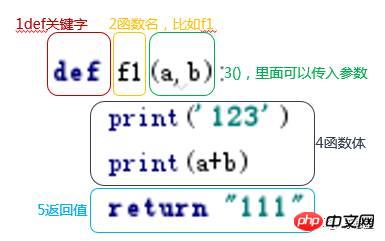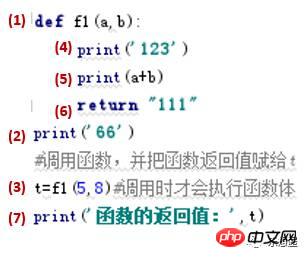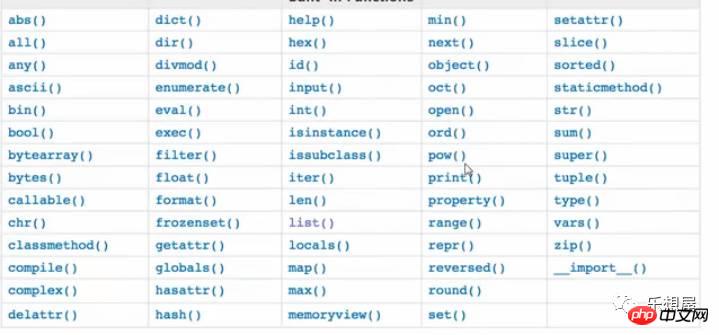Summary of functions of Python basic knowledge
This article shares with you a summary of functions of Python basic knowledge. The content is quite good. I hope it can help friends in need.
Functions: including custom functions and built-in functions <br>
1) Custom functions Structure: Contains five parts:
##def Keywords: Identifies the function used to create
Function name: For example, f1
():( ) There are parameters in it
Function body:Specific function to be achieved by this function
return: Return value, if none, return none
as shown below :

2) Function call: Use function name + ()
The form is: function name (parameter 1, parameter 2), such as f1 (5,8)
##3) Function execution order:from top to bottom Down.
And the function body is only executed when it is calledIf you want to get the return value of the function, you need to assign a value.
The statement after return in the function body will no longer be executed.
<br>


f1(): ()
<br>
Case 2, call the function and execute the function body. Once return is executed in the function body, it terminates immediately, so the subsequent print (456) will never be executed.f1():
()
()
f1()
案例3,结果为123、111,因为有return把值给了r,print(r)打印出来111 案例执行结果为:123、111 案例4:当函数无return的时候,自动默认返回值为None;返回结果为123、None,因为没有return,r接受到的值为None 案例执行结果为:123、none
案例5:python传递的是引用,不是复制,如下的li经过函数体执行后,已经被引用了 执行结果: [11, 22, 33, 44] [11, 22, 33, 44, 999] <br> 4)函数的参数:<br> 比如f(x1,x2,x3=1),x1,x2,x3则为参数 包含的参数类型有: 普通参数:形式参数和实际参数<br> 默认参数:提前给定值,比如x3<br> 指定参数:实际参数调用时,可以改变顺序指定 动态参数:<br> *args<br> **kargs<br> 万能参数*args,**kagrs <br> 案例1:区分形式参数和实际参数: 案例中的xxx为形式参数,调用函数时传递的为实际参数<br> <br> 案例2:理解参数的调用 普通参数,x1、x2,在f1里面按顺序传递 默认参数,如果设置,则该形式参数必须放后面,如x3,调用时不用再次传递 指定参数,指定参数可以改变顺序指定 案例3:动态函数(函数名前加*,或者**):一个形式参数,可以接受多个实际参数。 当形式参数带*时,默认将传递的参数放置在群组中 当实际参数为普通参数传递时,即使列表,也会被作为一个元素传递 当实际参数有*时,list所有的元素将相应的作为元祖的每一个元素 执行结果: ('55', 66, 'll') ([11, 22, 33, 'hhhh'],) (11, 22, 33, 'hhhh') <br> 当为**时,默认传递的参数放置在字典中,实际参数必须为指定参数或字典 案例4:如果形式参数为**,传递实际参数的时候也传递**,则会把整个字典传进去 执行结果:<br> {'n1': 'hh', 'n2': 'kk'} {'k1': 'n1', 'k2': 'n2'} <br> 案例5:万能参数:f1(*args,**args),必须*在前,**在后 执行结果 (11, 22, 33) {'k1': 'n1', 'k2': 'n2'} <br> 关于万能参数的应用,就是str.format 案例6:用占位符传递,这样是*arg的应用 执行结果: i am hh,age2 i am hh,age2 <br> 案例7:当形式参数为字符变量时,必须后面指定参数传递,为**arg的应用 执行结果: i am hh,age2 i am nn,age4 <br> 5)全局变量:作用在全局,用大写表示,如果要修改且作用于全局,则需要加global 案例1:全局变量:作用域在全局,用大写表示。<br> 案例2:修改全局变量:如果要修改且对全局有用,则可以用global 执行结果: 案例3:修改全局变量:不加global,则仅作用在函数内部 执行结果: <br> 6)三元\三目运算:即if..else的简称。 格式为:"为真时的结果 if 判定条件 else 为假时的结果" , 案例1:如果1==1条件成立,就等于前面的值,否则为后面的值hhh 6)lambda函数:目的就是简化用户定义使用函数的过程 案例1:lambda函数,简写函数,一个参数 #案例可以简写 案例2:lambda函数,简写俩参数 案例3:应用lambda函数 案例4:循环用法案例 7)python有很多内置函数,可以直接使用 可参考:http://www.cnblogs.com/vamei/archive/2012/11/09/2762224.htmlf1():
()
r=f1()
(r)
f1():
()
r=f1()
(r)
f1(a1):
a1.append()
li=[,,,]
(li)
f1(li)
(li)
f1(xxx):
()
xxx+r=f1()
(r)
<br>
f1(x1,x2):
x1+x2
r=f1(,)
f1(x1,x2,x3=):
x1+x2+x3
r=f1(,)
<br>
f1(x1,x2,x3=):
x1+x2+x3
f1(x2=,x1=)
(r)
(x,(x))
f1(,,)
li=[,,,]
f1(li)
f1(*li)
f1(**x):
(x,(x))
f1(=,=)
dic={:,:}
f1(**dic)f1(*a,**x):
(a,(a))
(x,(x))
f1(,,,**{:,:})s1=.format(,)
s2=.format(*[,])
(s1)
(s2)
=.format(=,=)
dic={:,:}
s2=.format(**dic)
()
(s2)=f1():
age=(age,)
f2():
age = (age, )
f1()
f2()

NAME=f1():
age=NAME
NAME = (age,NAME)
f2():
age = (age, NAME)
f1()
f2()

=f1():
age= = (age,)
f2():
age = (age, )
f1()
f2()

“condition ? true_part : false_part”
==:
name=:
name=name2===f1(a1):
a1+ret=f1()
(ret)
=a1:a1+r1=()
(r1)
=a1,a2:a1*a2+r1=(,)
(r1)
=[,,,,,]
key=w:[w]
r=key()
(r)
=n=alphabet=s3=[[:i]+c+[i+:] i () c alphabet]
(s3)
执行结果为:


The above is the detailed content of Summary of functions of Python basic knowledge. For more information, please follow other related articles on the PHP Chinese website!

Hot AI Tools

Undresser.AI Undress
AI-powered app for creating realistic nude photos

AI Clothes Remover
Online AI tool for removing clothes from photos.

Undress AI Tool
Undress images for free

Clothoff.io
AI clothes remover

Video Face Swap
Swap faces in any video effortlessly with our completely free AI face swap tool!

Hot Article

Hot Tools

Notepad++7.3.1
Easy-to-use and free code editor

SublimeText3 Chinese version
Chinese version, very easy to use

Zend Studio 13.0.1
Powerful PHP integrated development environment

Dreamweaver CS6
Visual web development tools

SublimeText3 Mac version
God-level code editing software (SublimeText3)

Hot Topics
 1386
1386
 52
52
 Can visual studio code be used in python
Apr 15, 2025 pm 08:18 PM
Can visual studio code be used in python
Apr 15, 2025 pm 08:18 PM
VS Code can be used to write Python and provides many features that make it an ideal tool for developing Python applications. It allows users to: install Python extensions to get functions such as code completion, syntax highlighting, and debugging. Use the debugger to track code step by step, find and fix errors. Integrate Git for version control. Use code formatting tools to maintain code consistency. Use the Linting tool to spot potential problems ahead of time.
 How to run programs in terminal vscode
Apr 15, 2025 pm 06:42 PM
How to run programs in terminal vscode
Apr 15, 2025 pm 06:42 PM
In VS Code, you can run the program in the terminal through the following steps: Prepare the code and open the integrated terminal to ensure that the code directory is consistent with the terminal working directory. Select the run command according to the programming language (such as Python's python your_file_name.py) to check whether it runs successfully and resolve errors. Use the debugger to improve debugging efficiency.
 Can vs code run in Windows 8
Apr 15, 2025 pm 07:24 PM
Can vs code run in Windows 8
Apr 15, 2025 pm 07:24 PM
VS Code can run on Windows 8, but the experience may not be great. First make sure the system has been updated to the latest patch, then download the VS Code installation package that matches the system architecture and install it as prompted. After installation, be aware that some extensions may be incompatible with Windows 8 and need to look for alternative extensions or use newer Windows systems in a virtual machine. Install the necessary extensions to check whether they work properly. Although VS Code is feasible on Windows 8, it is recommended to upgrade to a newer Windows system for a better development experience and security.
 Is the vscode extension malicious?
Apr 15, 2025 pm 07:57 PM
Is the vscode extension malicious?
Apr 15, 2025 pm 07:57 PM
VS Code extensions pose malicious risks, such as hiding malicious code, exploiting vulnerabilities, and masturbating as legitimate extensions. Methods to identify malicious extensions include: checking publishers, reading comments, checking code, and installing with caution. Security measures also include: security awareness, good habits, regular updates and antivirus software.
 What is vscode What is vscode for?
Apr 15, 2025 pm 06:45 PM
What is vscode What is vscode for?
Apr 15, 2025 pm 06:45 PM
VS Code is the full name Visual Studio Code, which is a free and open source cross-platform code editor and development environment developed by Microsoft. It supports a wide range of programming languages and provides syntax highlighting, code automatic completion, code snippets and smart prompts to improve development efficiency. Through a rich extension ecosystem, users can add extensions to specific needs and languages, such as debuggers, code formatting tools, and Git integrations. VS Code also includes an intuitive debugger that helps quickly find and resolve bugs in your code.
 Python: Automation, Scripting, and Task Management
Apr 16, 2025 am 12:14 AM
Python: Automation, Scripting, and Task Management
Apr 16, 2025 am 12:14 AM
Python excels in automation, scripting, and task management. 1) Automation: File backup is realized through standard libraries such as os and shutil. 2) Script writing: Use the psutil library to monitor system resources. 3) Task management: Use the schedule library to schedule tasks. Python's ease of use and rich library support makes it the preferred tool in these areas.
 Can visual studio code run python
Apr 15, 2025 pm 08:00 PM
Can visual studio code run python
Apr 15, 2025 pm 08:00 PM
VS Code not only can run Python, but also provides powerful functions, including: automatically identifying Python files after installing Python extensions, providing functions such as code completion, syntax highlighting, and debugging. Relying on the installed Python environment, extensions act as bridge connection editing and Python environment. The debugging functions include setting breakpoints, step-by-step debugging, viewing variable values, and improving debugging efficiency. The integrated terminal supports running complex commands such as unit testing and package management. Supports extended configuration and enhances features such as code formatting, analysis and version control.
 Can vs code run python
Apr 15, 2025 pm 08:21 PM
Can vs code run python
Apr 15, 2025 pm 08:21 PM
Yes, VS Code can run Python code. To run Python efficiently in VS Code, complete the following steps: Install the Python interpreter and configure environment variables. Install the Python extension in VS Code. Run Python code in VS Code's terminal via the command line. Use VS Code's debugging capabilities and code formatting to improve development efficiency. Adopt good programming habits and use performance analysis tools to optimize code performance.




